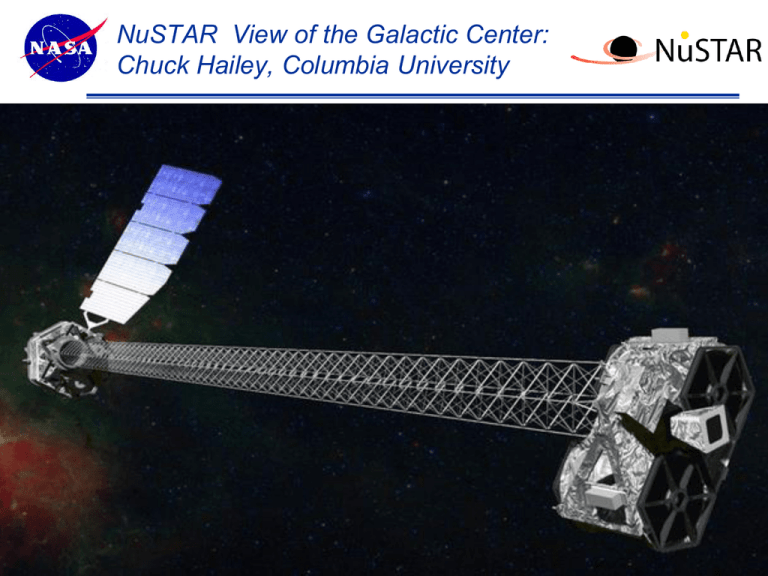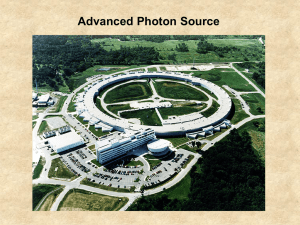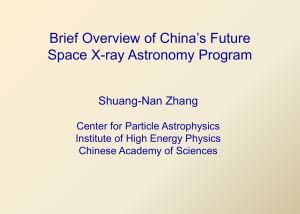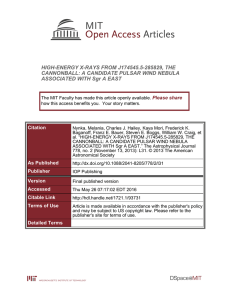NuSTAR Highlights - Columbia University
advertisement

NuSTAR View of the Galactic Center: Chuck Hailey, Columbia University Theme Message (List 3 strengths ?) 1 Outline • Non-thermal filaments in the Galactic Center •NuSTAR – Nuclear Spectroscopic Telescope Array • NuSTAR’s view of the Galactic Center • The Galactic Center at > 20 keV: • Discovery of diffuse hard X-ray emission (DHXE) in the inner ~10 pc • The Galactic Center at > 40 keV: • “Cusp” of hard X-ray emission in the inner ~1 pc Theme Message (List 3 strengths ?) • Non-thermal filaments in the Galactic Center 2 First high-energy X-ray focusing telescope in orbit 2. Deployable 10 m mast 1. Two co-aligned, multilayer coated, grazing incidence focusing optics 3. CdZnTe pixel detector Theme Message (List 3 strengths ?) spectrometers 3 NuSTAR telescope performance Harrison et al. (2013) • Energy Band: 3-79 keV • Angular Resolution: 58” (HPD), 18” (PSF) • Field-of-view: 12’ x 12’ • Energy resolution (FWHM): 0.4 keV at 6 keV, 0.9 keV at 60 keV • Temporal resolution: 0.1 ms • Maximum Flux Rate: 10k cts/s • ToO response: <24 hours Theme Message (List 3 strengths ?) 4 NuSTAR’s View of the Galactic Center • Observed the central ~0.5° of the Galaxy for ~700 ks in July through October 2012 • Part of larger, ~2 Ms survey of the Galactic Center region 700 ks INTEGRAL: 20-40 keV NuSTAR: 10-40 keV Belanger et al. 2006 • Will focus in this talk on the ~300 ks effective exposure time covering Theme Message (List 3 strengths ?) the central 5’ x 5’ Non-thermal X-ray filaments High-energy X-ray detection of G359.88-0.08 (Sgr A-E): Magnetic flux tube emission powered by cosmic-rays? S. Zhang et.al., Astrophysical Journal, 784, 6 (2014) High-Energy X-ray detection of G359.97-0.038 M., Nynka et al. (to be submitted) Date , 6 Non-thermal X-ray Filaments (NTF) observed by Chandra Dozens of filamentary structure with power-law spectra in X-ray were observed near Galactic Center, most, if not all, believed to be PWNe Theme Message (List 3 strengths ?) Date Chandra NTF Survey (Johnson et al. 2009) 7 Sgr A-E (G 359.88-0.08) is the brightest hard X-ray sources detected in the GC by NuSTAR • Brightest GC non-thermal filament (NTF) detected by NuSTAR up to ~ 50 keV. • Spectra best fitted with a simple absorbed power-law with photon index of ~2.3 +/- 0.2 (previous measurements range from 1.1 to 3.1). • Detected by NuSTAR as an extended source in 3-10 keV and a point-like source 10-50 keV bands. • The high energy (>10keV) centroid sits closer to the south-eastern end. Theme Message (List 3 strengths ?) Date NuSTAR 10-50 keV image overlaid with Chandra 2-8 keV contour. Joint NuSTAR+XMM-Newton spectra. 8 Sgr A-E source nature - PWN? Scenario 1: PWN (Lu et al. 2003, Johnson et al. 2009). Challenges: X-ray: Hard to explain the 10” offset between X-ray and radio emission. Radio: High resolution radio morphology does not support the PWN picture. Sgr A-F (Not detected by NuSTAR) ~10” offset between X-ray and radio emission. Sgr A-E Sgr A-F Sgr A-E Theme Message (List 3 strengths ?) Date Chandra 2-8 keV image overlaid with VLA 20-cm contour. 9 JVLA (B and C arrays) 6-cm continuum map (Morris et al.). Sgr A-E source nature – SNR-MC Interaction? VLA 20-cm continuum map Scenario 2: SNR G359.92-0.09 shell interacting with the 20 km/s cloud (Ho et al. 1985, Yusef-Zadeh et al. 2005). Challenges: 1. No applicable SNR-MC interaction theories can explain the X-ray emission (photon index ~2.3) up to 50 keV (e.g. Bykov et al. 2000, Tang et al. 2011) . SNR G359.92-0.09 Sgr A-F Sgr A-E 2. No sharp filaments at one spot of the shell observed in confirmed SNR-MC interaction cases such as W28, W44, W51C and IC443. Also, no GeV point source reported consistent with this position Theme Message (List 3 strengths ?) Date 10 Bykov model Tang model Sgr A-E – A Magnetic Flux Tube? Scenario 3: Magnetic Flux Tube: Relativistic electrons trapped in locally enhanced magnetic fields (e.g. Yusef-Zadeh et al. 1984, Tsuboi et al. 1986). Possible TeV electrons source 1: • Old PWNe with ages up to ~100 kyr extending up to ~10 pc observed by Suzaku. • PWN magnetic field must decease with time. • Electrons accelerated up to ~80 TeV can survive and extend up to 20-30 pc without losing most energies if magnetic filed decays to a few microGauss(Bamba et al. 2010). Possible TeV electron source 2: •Cosmic-ray protons diffuse from SMBH or SNe in GC •Secondary electrons produced by cosmic-ray-molecular cloud interaction •For energies <~ 100 TeV, electrons can escape typical size molecular cloud Predicts positional correlation between bright, hard X-ray filaments and Theme Message (List 3 strengths ?) molecular clouds Date 11 GC filaments and clouds overlaid with HESS residual map Aharonian et al. 2006 (diffuse, ridge) Theme Message (List 3 strengths ?) Date Filaments are associated with molecular clouds. 12 Hard X-ray filaments are adjacent to 50 km/s molecular cloud (CS map) Theme Message (List 3 strengths ?) Tsuboi 1999 CS map NuSTAR detected hard X-ray emission from Sgr A and B2 NuSTAR detected Sgr A clouds above 10 keV. Arches cluster (Krivonos et al. ApJ, 2013) Analysis of Sgr A clouds in progress Sgr B2 rapidly fading but was detected above 10 keV by NuSTAR NuSTAR 10-40 keV image showing Sgr A clouds (naming follows Ponti et al.) Theme Message (List 3 strengths ?) Date 14 Our sources of interest overlaid on HESS GC map with HESS GC source subtracted Aharonian et al. 2006 (diffuse, ridge) Theme Message (List 3 strengths ?) Date GC Molecular clouds are hard X-ray and TeV emitters. 15 Discovery of Extended Hard X-ray Emission in the Galactic Center K. Perez et. al. (submitted today) Theme Message (List 3 strengths ?) Date 16 NuSTAR’s View of the Galactic Center NuSTAR 3-79 keV CHANDRA 2-10 keV Sgr A* Sgr A Plume Sgr A East E Theme Message (Listof 3 strengths ?) Same sources emission observed by CHANDRA dominate the NuSTAR 3-79 keV view 17 Inner 5’ x 5’: 3-10 keV • The brightest emission (white) comes from the hot plasma surrounding Sgr A* and the PWN G359.95-0.04 • The surrounding emission (red and yellow) fills the shell of supernova remnant Sgr A East • To the north-east lies the extended emission of the Sgr AEast “plume” (bright blue) • The entire region sits in a field of diffuse and unresolved point source emission (dark blue) Theme Message (List 3 strengths ?) 18 Inner 5’ x 5’: 10-20 keV • Emission from near Sgr A* and G359.95-0.04 still dominates • Dimmer, but persistent emission inside the Sgr AEast shell • The “Cannonball” neutron star (Nynka 2013) and the non-thermal filaments G359.954-0.052 and G359.97-0.038 (Nynka 2014) Theme Message (List 3 strengths ?) 19 The Galactic Center at 20-40 keV There is a pervasive, diffuse >20 keV X-ray emission from the Galactic Center • Thermal emission from Sgr A East is no longer present • Only non-thermal filament, Cannonball, and bright central emission remain Theme Message (List 3 strengths ?) 20 Spatial Model of 20-40 keV Emission • Fit 20-40 keV image [cts/s] to: (Symmetric Gaussian + Asymmetric Gaussian) ✕ PSF + detector bkgd a “point-like” source, spatially consistent with both Sgr A* and the PWN G359.95-0.04 an extended source, with FWHM = 8 pc x 4 pc 20-40 keV data Extended Pt-source Background Theme Message (List 3 strengths ?) Spectrum of “Southwest” region • Below 20 keV dominated by: kT,1 = 1.0 +0.3-0.4 keV Z1 = 5.0 kT,2 = 7.5 +1.6-1.3 keV Z2 = 1.7 low-energy unresolved emission • L2-10/M of low-energy thermal component in this region (|r| ~ 3 pc) consistent with that measured by XMM-Newton at |R| ~ 4 pc (Heard and Warwick 2012; Launhardt 2002) SW SW Theme Message (List 3 strengths ?) 3- 10 keV 20-40 keV • Above 20 keV dominated by: Γ = 1.5+0.3-0.2 F(20-40 keV) = 6.7e-13 erg s-1 cm-2 22 Origins of Diffuse Hard X-ray Emission (DHXE) Consistent 20-40 keV spectral and flux values in both regions indicates that the DHXE is: • symmetric along the Galactic plane around Sgr A* • non-thermal with Γ ≈ 1.6 or thermal with kT ≈ 60 keV • L(20-40 keV) ≈ 2.4×1034 ergs/s within the 8 pc × 4 pc FWHM Any possible explanation of the DHXE must account for: • observed spatial distribution • constraints from previous X-ray observations • spectral characteristics Theme Message (List 3 strengths ?) Leading candidates are stellar populations whose densities are expected to trace the near-infrared light distribution 23 Hot Intermediate Polars ? Scenario 1: Anomalously hot Intermediate Polars (IPs) with kT ≈ 60 keV • much hotter than the kT ≈ 8 keV in the inner arcminutes (Muno 2004; Heard and Warwick 2012) or kT ≈15 keV observed in the inner Galactic bulge (Yuasa 2012) • Swift, INTEGRAL, Suzaku, and XMM-Newton measurements of individual IPs show an average temperature of kT ≈ 20 keV, but exhibit a range in temperature from kT ≈ 10 keV to kT ≈ 90 keV • Assume Lmin(2-10 keV) ≈ 1030 – 1031 erg/s Lmax(2-10 keV) ≈ 1033 erg/s α ≈ 1.0-1.5 800 – 8000 IPs in 8 pc × 4 pc 6-60 IPs pc-3 • Observed spectrum implies white dwarf mass MWD > 1.0 M • Ensemble mass is significantly higher than that measured for mCVs in either the Galactic Center or bulge, though Theme Message (List 3 strengths ?) individual IPs with similar masses have been observed in the local solar neighborhood 24 Black hole low-mass X-ray binaries ? Scenario 2: Quiescent black hole low-mass X-ray binaries (qBH-LMXB) • Knowledge of the luminosity of qBH-LMXBs is limited to 10 known systems • For Lmin(2-10 keV) ≈ 2-4 × 1031 erg/s 600-1200 qBH-LMXBs • In the last decade, X-ray monitoring surveys uncovered virtually all transient systems within the inner 50 pc of the Galaxy with • recurrence times of < 5-10 years • outburst durations longer than a few days • outburst L(2-10 keV) > 1034 erg/s Typical qBH-LMXB with Tr ~ 50-100 years could make up at most 10% of DHXE • Long Tr, long outburst BH-LMXB such as GRS 1915+105 also cannot dominate • Fainter, non-transient BH-LMXB have been proposed (Menou 1999)(Casares 2014): the transition radius between the advection dominated accretion flow and the Theme Message (List 3 strengths ?) normal thin accretion disk is at large enough radius that the outer disk is always cool 25 Millisecond pulsars? Scenario 3: millisecond pulsars; old rotation-powered neutron stars spun up in period to ~ 10 msec • typical photon index of 1-2 in the hard X-ray band • For Lmin(2-10 keV) ≈ 10^30-10^33 erg/s; black body emission ~ 0.1-0.3 keV too soft to be observed at Galactic Center • spin down powers range from ~4x10^32 – 2x10^36 erg/s and with L(2-10 keV) ~ 10^-4 * spin down power >> L(2-10 keV) ~ 6x10^30 erg/s •Require ~ 3000 MSP to explain entire emission •~ 96% of these MSP would be below Chandra detection limit and the remaining < 4% are a very small fraction of the resolved Chandra sources in the hard X-ray observed regions Theme Message (List 3 strengths ?) 26 Alternate populations Although explanations in terms of hot IPs, qBH-LMXBs, or MSPs present challenges, other possible populations have been ruled out as majority contributors to the DHXE. • Neutron star LMXBs have typical Tr ~ 5-10 years, would have been detected by Swift monitoring • Magnetars with consistent spectra (soft gamma repeaters) have typical Tr ~ 10 years • A large enough population of non-thermal filaments is not supported by Chandra or radio mapping of the Galactic center • Low surface brightness PWN would require at least x10 higher PWN birth rate • Inverse Compton from electrons injected from PWN, Sgr A*, colliding winds etc. scattering in the high radiation density of the center has a luminosity too low Theme Message (List 3 strengths ?) • Dark matter does not reproduce spatial extent 27 The Galactic Center at >40 keV • One strong source dominates, consistent with both the Chandra Pulsar Wind Nebula G359.95-0.04 and the HESS TeV source J1745-290 • The INTEGRAL >20 keV source IGR J17456-2901 is not visible • A marginal-significance “protrusion” to the south-west extends beyond the circumnuclear disk but not associated with obvious radio features Theme Message (List 3 strengths ?) 28 Summary NuSTAR is revealing a (more) complicated story concerning the nature of the Chandra X-ray emitting non-thermal filaments, import to combine with GeV and TeV observations to identify their nature. NuSTAR has clarified the nature of the INTEGRAL soft gammaray sources in the Galactic Center, and detected the pulsar wind nebula closest to the supermassive black hole Emission from Sgr A-East at hard X-rays is entirely thermal NuSTAR Galactic Plane survey has discovered many point sources and detected many molecular clouds in hard X-rays, such as the rapidly fading Sgr B2. TeV observations are useful to the molecular clouds study. A hitherto unknown and pervasive diffuse hard X-ray emission has been detected by NuSTAR. Its origin is probably due to undetected point sources such as LMXB, mCVs or MSPs. Theme Message (List 3 strengths ?) Date 29 THE END: thanks to the NuSTAR Galactic Survey Team and collaborators Nicolas Barriere, Steve Boggs, Bill Craig, Roman Krivonos, John Tomsick (UC Berkeley) Fiona Harrison (PI), Kristin Madsen, Brian Grefenstette (Caltech) Eric Gotthelf, Kaya Mori, Melanie Nynka, Kerstin Perez, Shuo Zhang (Columbia University) Finn Christensen (Danish Technical University) Josh Grindlay, Jaesub Hong (Harvard-SAO) Fred Baganoff (MIT) Daniel Stern (NASA JPL); Daniel Wik, Will Zhang (NASA GSFC) Franz Bauer (Universidad Catolica); J. Zhao (Harvard-SAO), M. Morris (UCLA) and W. Goss (NRAO) Theme Message (List 3 strengths ?) Date 30




